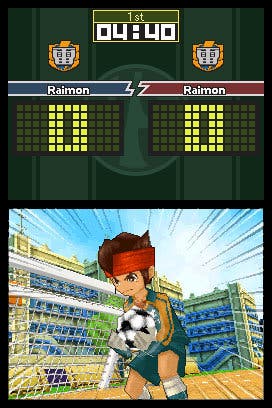Inazuma Eleven
A game of two halves.
Fetch the violins: I love football, but have always been crap at it. Whoever at Level-5 is responsible for Inazuma Eleven's concept is, I'd bet, in exactly the same boat: an enthusiast rather than an expert, the first to every match but one of the last to be picked. They know the dull ache of the substitutes' bench, or something like it. Inazuma Eleven isn't just a football game; it's a game about the love of football.
And one that's knocking on a bit. It's taken Nintendo over three years to release Inazuma Eleven in the UK, in which time it's not only been available in Japan, America and the rest of Europe, but has had two DS sequels and a Wii spinoff. Its age isn't nearly enough to warn you away from this, but Inazuma Eleven can feel clunky in terms of its menu screens and overall interface, which are aspects the series has since refined. But hey, this is Nintendo Europe, so let's party like it's 2008.
You play Mark Evans, a plucky young goalkeeper who's football-mad and the captain of his school team - which, at the start of the game, doesn't even have enough players for a match. The school is the hub for Inazuma Eleven, with most chapters constructed around a single match against a themed opposition team, and another chunk of the story to take you around the world map - a still screen that lets you jump from place to place.
These sections of the game are pure RPG and, while Inazuma Eleven has plenty of byways and side streets to be explored, the story's linearity isn't helped by a massive arrow pointing to where you need to go next and the objectives constantly being spoonfed.

As the game progresses the story ascends into true lunacy. What begins as a quest to get together some mates for a kickabout soon turns into a Power Rangers-style battle for life as we know it, with high-school football deciding the fate of the universe and waves of flaming, teleporting footballs fired at hapless goalkeepers.
Like Power Rangers, there's some pretty terrible dubbing going on. Mark sounds suspiciously similar to Professor Layton's irritating assistant Luke, and when Inazuma Eleven has its story moments you'll swiftly learn to pray for the ones that are text-only. Perhaps it's just me, but high-pitched faux-Cockney does nothing so much as conjure up the ghastly spirit of Dick Van Dyke.
After the introductory hour, walking around the overworld will begin to trigger random battles - miniature football matches with four players on each side, and a specific objective like scoring the first goal or simply acquiring possession of the ball.

They're quick to set up and the time limits are tight (each one's a quick blast rather than a drawn-out encounter) and though there's a penalty for losing these matches (a few Prestige and Friendship points, which are used to buy items and attract new players) it's never so onerous you'll dread a defeat. The game gets on with things, and so do you. Though you may wonder why a draw counts as a defeat.
Inazuma Eleven's main matches, on the other hand, are where it absolutely shines. These are full 11-a-side matches and show off the unique take on football at its best: a strange mix of stylus gymnastics and turn-based strategy. Drawing lines on the touch-screen sends players running in that direction, and when in possession they'll automatically run towards the opposition goal. You tap another member of the team to pass, or tap the player to speed them up.
Getting the hang of the basics is easy enough, but this is a game of hidden depths - not the least of which is the simple 'Time Out' button. It's absolutely essential. Only about an eighth of the pitch can be seen at once, and panning around it when everything's moving is like rubbing your tummy and patting your head. Using time-outs lets you prepare runs for every member of your team, as well as the next pass.
It turns a system that initially feels too automated into an interpretation of football like nothing else out there - a cross between direct tactical instruction and real-time action that's almost brilliant.


